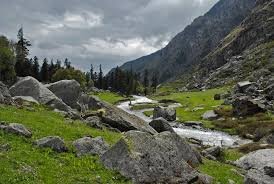Har Ki Dun Trek
book your tour via whatsapp

Region
Himanchal Pradesh

Duration
5 Days

Altitude
14,000 Ft.

Base Camp
Manali

Best Time to Visit
June To Sep
Overview of the Har Ki Dun Trek: An Entryway to the Himalayan Wonderland
Altitude: ~12,000 feet (3,650 meters)
Duration: 7 Days (Including travel from Dehradun)
Difficulty: Easy to Moderate
Trek Distance: ~47–52 km round trip
Best Time to Visit:
Summer: April to June
Post-Monsoon / Autumn: September to November
❄️ Snow Trek (Optional): December to mid-March
One of Uttarakhand, India’s most beautiful and historically significant treks is the Har Ki Dun Trek, sometimes referred to as the Valley of Gods Trek. This 7-day trek, which is tucked away in the Govind Pashu Vihar National Park, offers breathtaking views of Swargarohini, Black Peak, and Bandarpoonch as it leads hikers through historic villages, alpine meadows, and snow-capped peaks.
Since it is thought that the Pandavas from the Mahabharata used this exact path to reach heaven, this trek is the ideal fusion of mythology and scenic beauty. Trekkers can see a centuries-old wooden temple devoted to Duryodhana in Osla village, which is also located in the Har Ki Dun Valley.

Why is Har Ki Dun Trek Famous?
Ancient Villages: You will travel through villages like Osla and Gangad, which are 2,000 years old and distinguished by their distinctive wooden architecture.
Mythological Origins: The journey is associated with the Mahabharata, as it is thought that the Pandavas used this path to reach the heavens.
Lush Meadows & Forests: You will see alpine meadows (bugyals), pine forests, riverbank trails, and waterfalls.
Swargarohini View: The hike provides a breathtaking view of the fabled “stairway to heaven,” Swargarohini Peak.
| Feature | Details |
|---|---|
| Total Trek Days | 5 trekking days + 2 travel days |
| Trek Grade | Easy to Moderate |
| Max Altitude | 3,650 meters (12,000 ft approx) |
| Base Village | Sankri |
| Region | Garhwal Himalayas, Uttarakhand |
| River | Supin River |
Trek Itinerary: Har Ki Dun Trek from Dehradun
🚌 Day 1: Dehradun to Sankri (Drive – 200 km / 8-10 hrs)
Altitude: 1,950 m
Drive along Yamuna and Tons rivers via Mussoorie, Purola, and Mori.
Stay: Guesthouse at Sankri
🥾 Day 2: Sankri to Taluka (Drive 12 km) | Taluka to Seema via Gangad (Trek – 10 km)
Trail follows the Supin River through forests of pine and walnut.
Stay: Campsite or homestay near Seema village
🥾 Day 3: Seema to Har Ki Dun Valley (Trek – 12 km)
Altitude gain: Up to 3,650 m
Long trekking day with vast alpine meadows and Swargarohini peaks.
Stay: Campsite at Har Ki Dun
🏞️ Day 4: Acclimatization + Exploration Day at Har Ki Dun
Explore nearby Jaundhar Glacier viewpoint or Maninda Tal
Optional hike to Hata Valley
Photography, relaxation, and snow fun (in winter)
🥾 Day 5: Har Ki Dun to Seema (Trek – 12 km)
Retrace your path, mostly downhill
🥾 Day 6: Seema to Taluka (Trek – 10 km) | Taluka to Sankri (Drive – 12 km)
Return to Sankri; warm food and local culture
🚌 Day 7: Sankri to Dehradun (Drive – 200 km / 8-10 hrs)
Har Ki Dun Trek – 7 Days Itinerary (Ex-Dehradun)
Region: Garhwal Himalayas, Uttarakhand
Maximum Altitude: ~3,650 meters (12,000 feet)
Trek Duration: 47–52 km total (5 trekking days)
Start/End Point: Dehradun
Difficulty Level: Easy to Moderate
Day 1: Scenic Mountain Drive from Dehradun to Sankri
200 km | 8–10 hours by road
1,950 meters above sea level
Highlights include the Yamuna Valley, Purola, Mori, and pine forests.
Accommodations: Sankri Guesthouse/Homestay
Route:
At approximately 6:30 AM, report to the Dehradun Railway Station.
Travel along the Yamuna and Tons rivers on the lovely hill roads.
Enjoy stopping in the area for lunch or breakfast en route.
Arrive in Sankri by nightfall; rest and check your equipment.
An orientation and acclimatization tour of Sankri village
Day 2: Drive from Sankri to Taluka and Trek to Seema via Gangad; Drive
Distance: 12 km; Trek Distance: approximately 10 km
Altitude Gain: Seema (2,600 m) → Taluka (2,100 m)
Highlights include the ancient Gangad village, the Supin River, and dense forests.
Stay: Seema Homestay/Camping
Route:
Drive from Sankri to Taluka in the early morning (rough mountain road in a jeep)
Start your journey through rhododendron, pine, and deodar forests along the Supin River.
Visit the charming village of Gangad, which is a fantastic location for cultural photography.
Before arriving at Seema campsite, cross streams, wooden bridges, and simple climbs.
A hot meal under the stars
Day 3: Har Ki Dun Valley to Seema
Trek Time: 6–7 hours | Distance: ~12 km
Gain in Altitude: 2,600 m → 3,500 m
Highlights include the Kala Gaad stream, verdant meadows, and the first glimpses of Swargarohini.
Stay: Har Ki Dun campground
Route:
To arrive at the magnificent Har Ki Dun valley by the afternoon, start early.
With expansive meadows, hanging glaciers, and snow-capped peaks, the trek becomes increasingly alpine.
Cross bridges and progressively climb through forest paths with stone pavement.
The last section leads to an incredible valley encircled by peaks such as Swargarohini, Black Peak, and Hata Peak.
A campsite offering a stunning 360-degree panorama of the snow-capped mountains
Day 4: Har Ki Dun Acclimatization and Exploration Day
Trekking options include Hata Valley or Jaundhar Glacier Viewpoint (approximately 4-5 km round trip).
3,650 meters above sea level
Route:
Savor breakfast while watching the sunrise over the Himalayas.
A quick hike to the Jaundhar Glacier viewpoint offers sweeping views of the ridgelines and snowfields.
Maninda Tal, a tiny alpine lake in Hata Valley, is open for optional visits.
Take the day to photograph the unspoiled splendor, observe Himalayan birds, or simply practice silent meditation.
Head back to the campsite for cozy meals and campfire storytelling.
Day 5: Return Trek from Har Ki Dun to Seema
Trek Time: 5–6 hours | Distance: 12 km
Loss of Altitude: 3,650 m → 2,600 m
Stay: Gangad homestay or Seema campsite
Route:
Go back downhill with less climbing and better footing.
Take pleasure in strolling through pine forests and crossing streams once more.
Spend some time taking pictures and interacting with the locals in the villages along the way.
Snacks, stories, and stargazing during the evening
Day 6: Travel from Seema to Taluka (Trek) and then drive to Sankri; the trek is 10 km and the drive is 12 km.
Accommodation: Sankri Guesthouse
Route:
The last day of the trek is primarily downhill and includes both forest and riverbed trails.
Arrive in Taluka by afternoon, then take a jeep to Sankri.
Freshen up at guesthouse and enjoy the evening with your group
Last-night celebration with local food, music (optional), and team bonding
Day 7: Trek End: Sankri to Dehradun; 200 km; 8–10 hours
Dehradun Railway Station is the drop-off location (by evening ~7 PM).
Route:
Early departure from Sankri
As you descend into the foothills, take in your final views of the mountains.
Reach Dehradun by late at night; services will conclude.
How to Reach Sankri (Base Village)
Nearest Airport: Jolly Grant Airport, Dehradun (210 km)
Nearest Railway Station: Dehradun Railway Station
From Dehradun, Sankri is accessible via shared jeeps/private cabs or pre-arranged transport with your trekking operator.

Kedarkantha Trek (Winter snow trek, starts from Sankri)
Bali Pass Trek (More challenging route from Har Ki Dun)
Ruinsara Tal Trek (Lake trek extension from Har Ki Dun valley)

Beginners looking for their first multi-day Himalayan trek
Nature lovers who prefer scenic landscapes over technical climbs
Families or groups wanting a cultural, safe trek

The Har Ki Dun Trek isn’t just a walk through mountains — it’s a journey through history, mythology, and untouched Himalayan beauty. Whether you trek for nature, solitude, or to experience a living Himalayan culture, Har Ki Dun delivers a fulfilling, non-commercial experience.
Inclusions (Typical Trek Package)
Transportation from Dehradun to Sankri and back
All meals during trek (veg)
Accommodation in guesthouses/camps
Trek leader & local guide
Permits & forest entry fees
Mules/porters for common gear
Exclusions
Meals during transit
Personal expenses & gear
Emergency evacuation costs
Bottled water or beverages
Essentials of Packing for the Har Ki Dun Trek
Wearing gloves, a cap, a down jacket, a raincoat or poncho, and thermal layers
Footwear: woolen socks and ankle-high trekking shoes
Accessory items include sunglasses, lip balm, sunscreen (SPF 50+), and a torch or headlamp.
Equipment: Trekking pole, daypack (20L), and backpack (50–60L).
Other: Water bottles, energy bars, and personal medications
Trekking Gear Checklist for Himalayan Treks
Essential for: Har Ki Dun, Kedarkantha, Valley of Flowers & similar treks
Note: Pack light but smart. Stick to essentials for safety, comfort, and ease.
| Item | Quantity | Notes |
|---|---|---|
| Rucksack with rain cover | 1 | 50–65L recommended |
| Daypack / Small Backpack | 1 | For summit day or short hikes |
| Waterproof bag covers/dry bags | Optional | For organizing gear inside |
| Item | Quantity | Notes |
|---|---|---|
| Head torch with spare batteries | 1 | Torch is better than hand-held for hands-free use |
| Water bottles (1 liter each) | 2 | Steel or BPA-free plastic |
| Water purification tablets | Optional | Especially for treks without filtered water |
| Item | Quantity | Notes |
|---|---|---|
| UV protection sunglasses | 1 | Must-have in snow/bright zones |
| Sun hat / trekking cap | 1 | Wide-brimmed for sun protection |
| Woolen cap | 1 | For chilly evenings and mornings |
| Item | Quantity | Notes |
|---|---|---|
| High-ankle trekking shoes (non-skid) | 1 pair | Must be broken in; waterproof preferred |
| Lightweight sandals/slippers | 1 pair | For use in campsites |
| Item | Quantity | Notes |
|---|---|---|
| Quick-dry warm lower / trekking pants | 2 | Avoid jeans or cotton pants |
| Full sleeve T-shirts / sweatshirts | 1 for every 2 days | Prefer dry-fit or wool blend |
| Thick woolen socks | 1 pair for every 2 days | Keep one extra dry pair |
| Thermal inner (upper & lower) | 1 set | Especially useful in higher altitude |
| Undergarments | 1 per trekking day | Lightweight, quick-dry preferred |
| Insulated warm jacket | 1 | Prefer windproof and water-resistant jacket |
| Full-sleeve woolen sweater | 1 | Layering helps regulate temperature |
| Rainwear (jacket & pants) | 1 | Poncho not recommended in wind |
| Waterproof warm gloves | 1 pair | Essential in cold & snowy conditions |
| Item | Quantity | Notes |
|---|---|---|
| Quick-dry warm lower / trekking pants | 2 | Avoid jeans or cotton pants |
| Full sleeve T-shirts / sweatshirts | 1 for every 2 days | Prefer dry-fit or wool blend |
| Thick woolen socks | 1 pair for every 2 days | Keep one extra dry pair |
| Thermal inner (upper & lower) | 1 set | Especially useful in higher altitude |
| Undergarments | 1 per trekking day | Lightweight, quick-dry preferred |
| Insulated warm jacket | 1 | Prefer windproof and water-resistant jacket |
| Full-sleeve woolen sweater | 1 | Layering helps regulate temperature |
| Rainwear (jacket & pants) | 1 | Poncho not recommended in wind |
| Waterproof warm gloves | 1 pair | Essential in cold & snowy conditions |
Final Tips:
Avoid cotton clothes – they don’t dry quickly.
Label your gear – especially if traveling in a group.
Carry extra ziplock bags to store wet/damp clothes.
Practice packing before the trek to balance your load.
Frequently Asked Questions: Har Ki Dun Trek
 1. What is the location of Har Ki Dun?
1. What is the location of Har Ki Dun?
Har Ki Dun is situated in the Garhwal Himalayas’ Govind Pashu Vihar National Park in Uttarakhand’s Uttarkashi district. It provides views of Swargarohini, Hata Peak, and Black Peak and is located close to the Himachal Pradesh border.
 2. When is the best time to trek Har Ki Dun?
2. When is the best time to trek Har Ki Dun?
April through June is summer, with lush, green forests and comfortable temperatures.
Clear mountain vistas are ideal for photography in the fall (September to November).
Experience a snow trek in the winter (December to March) (only for experienced trekkers)
 3. How challenging is the Har Ki Dun Trek?
3. How challenging is the Har Ki Dun Trek?
The trek to Har Ki Dun is rated as Easy to Moderate. Over the course of five days, participants will walk 6–12 km per day, with gradual ascents leading to a maximum elevation of roughly 3,650 meters (12,000 feet). Fit beginners can use it.
4. What is the duration of the Har Ki Dun Trek?
Over the course of five trekking days, the total distance covered is approximately 47–52 km. The trek typically takes seven days, including travel time from Dehradun.
 5. What is the trek’s highest elevation?
5. What is the trek’s highest elevation?
Around 3,650 meters (12,000 feet) above sea level is the highest point on the Har Ki Dun Trek.
 6. Is the Har Ki Dun trek safe for women or lone travelers?
6. Is the Har Ki Dun trek safe for women or lone travelers?
In general, it is safe. The area is renowned for its tranquil atmosphere and friendly residents. Join a reputable trekking organization like Secure Travels, which has certified guides and staff who are friendly to women, if you are traveling alone or as a female.
 7. Is prior trekking experience required?
7. Is prior trekking experience required?
You should be physically fit, but no prior experience is necessary. Strength training two weeks prior to the trek and light aerobic exercise (jogging or walking five kilometers each day) will be beneficial.
 8. What sort of lodging is offered during this hike?
8. What sort of lodging is offered during this hike?
Among the accommodations are:
Sankri guesthouses
During the trek, there are campsites or homestays (Har Ki Dun, Seema). Tents are typically shared by two or three people.
 9. Is there access to mobile networks while trekking?
9. Is there access to mobile networks while trekking?
Limited connectivity (Jio/BSNL) at Sankri
No dependable mobile network after Sankri
Before you start, let your family know. Emergency communication devices are typically carried by guides.
 10. What is the temperature like during the trek?
10. What is the temperature like during the trek?
| Month | Day Temperature | Night Temperature |
|---|---|---|
| April–May | 10°C to 18°C | 0°C to 5°C |
| Oct–Nov | 8°C to 15°C | -3°C to 4°C |
| Dec–Feb | -2°C to 8°C | -10°C to -2°C |
Fitness For Trekking for Har Ki Dun Trek
Tips to get fit for Trekking
Experiencing trek is almost everyone’s passion or dream. But before starting or planning for a hike, you must be aware of the during and post-trek pain of your body. It is essential to be strong enough to enjoy your whole trek without any disruption of body ache. One book or decide several months before going on a hike, so you have a significant amount of time exercising your body and training it to become flexible for the trek.
Following are some advantages of training yourself before trek:
- It fosters aerobic fitness.
- It improves blood circulation and breathing functions as well.
- It makes the heart strong, preventing it from any problem.
- It helps in toning legs.
- Muscles get build-up which is very beneficial.
Therefore, one must do practice to gain all these benefits. It is not only for the trek but for lifetime fitness also.
Let’s have a look at some factors which must be kept in mind to practice before trek:
Importance of Stretching
It helps the body become flexible and allows you to move your body in any direction you want quickly. It helps make the joints such as shoulders, elbows, hips and knees stronger to prevent any mishappening. It provides much relaxation to your body and relieves the pain. And if you are going on a trek, it is essential to practice stretching way before your hike. It will help you in moving to the higher altitudes region more efficiently.
Sleep like baby
It is always said that one must sleep like a baby. It means sleep without any worries. This makes you have an adequate amount of sleep which is a significant factor in daily life. So, practice it daily and also before your trek. Try to make yourself comfortable to sleep at higher altitudes.
Good Shoes-Good Trek
It is so evident that one has to walk and only walk while Trekking, so it is far more essential to have a good pair of trekking/hiking shoes. Practice walking by wearing your boots before the trek to make yourself used to them. You may opt for an option to keep an extra pair in your bag while trek to help yourself in the opposite condition.
Har Ki Dun Trek Requires Fitness
🟢 Trek Grade: Moderate to Easy Elevation Maximum: approximately 3,650 meters (12,000 feet)
Trek Length: 5 days (47–52 km total)
Who Is Capable?
Beginners’ fitness
Trekkers who are new to high altitude
Trekkers with basic endurance who are between the ages of 10 and 55
✅ Reasons for Being Fit
Although Har Ki Dun isn’t a strenuous or technical hike, it does require a high level of endurance. Carrying your backpack, you will walk 6–12 km every day, frequently at altitudes higher than 3,000 meters where oxygen levels are lower.
Even this “easy” hike can leave you exhausted, breathless, and vulnerable to AMS (Altitude Mountain Sickness) if you are not prepared.
Begin getting ready at least two weeks in advance.
Light training for two to three weeks is sufficient if you are reasonably active. Start four weeks in advance if you are sedentary.
🏋️♂️ Har Ki Dun Fitness Training Program
1. Cardio (most crucial)
Objective: Increase lung endurance and capacity.
Spend 30 to 45 minutes each day doing one or a combination of these:
Walking quickly (5 km/day)
Running on a treadmill or jogging (3–5 km)
Climbing stairs (20–30 floors per day)
Swimming or cycling
2. Leg Strength Objective: Get legs ready for walking up and down hills.
Perform three sets of 15–20 repetitions of:
Squats
Lunges
Raising the calf
Wall sits (wait a minute)
3. Core Strength Objective: Enhance equilibrium and lessen back strain.
Perform crunches, side planks, and planks (30–60 seconds).
Quick Enquiry
Ex: Sankri To Sankri
INR 7,499+ 5% GST
Ex: Dehradun To Dehradun
INR 8,999+ 5% GST
Payment Mode: Cash, UPI, Bank Transfer
Trek Info
- Region : Uttarakhand
- Trek Distance: 48 Kms
- Duration: 6N/7D
- Altitude: 11,768 Ft
- Best Time To Visit: March To June and Sept To Nov
- Trek Grade: Easy To Moderate
- Pickup Point: Dehradun
- Drop Point: Dehradun
- Snow: Dec To Mar
Need Help?
Call To Expert:
+91-7302011153
❤ GUIDES
Certified, Experienced, Soft Spoken and Well Mannered Local Trekking Guides
❤ EXPERTISE
We have been managing trekking events from last few years, which proves that we are experts of our field.
❤ 1000+ TOURS DONE
Till now we have done more than 1000 tours across India.
❤ POCKET FREINDLY PACKAGES
Our packages are very cost effective as compare to other travel agencies.
❤ VERIFIED REVIEWS
Our customers review us as one of the best trekking agency in Uttarakhand.
